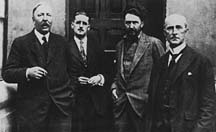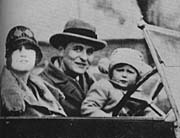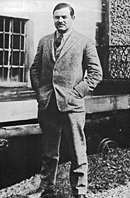|
HEMINGWAY'S PARIS ~ Part 2
|

The Lost Generation
The Left Bank
References to the Left Bank have never lost their power to evoke
the most piquant images of Paris. The Left Bank's geographic and
cerebral hub is the Latin Quarter, which takes its name from the
university tradition of studying and speaking in Latin, a practice
that disappeared at the time of the French Revolution. The area is
populated mainly by students and academics from the Sorbonne, the
headquarters of the University of Paris. Most of the St-Germain
cafés, where the likes of Sartre, Picasso and Hemingway spent
their days and nights, are patronized largely by tourists now. Yet
the Left Bank is far from dead. It is a lively and colorful district,
rich in history and character. To the south, dwarfed beneath its
59-story Tower, lies Montparnasse, the bohemian center of interwar
Paris.
 During the 17th century,
students from the Latin Quarter had jokingly given this area the
pompous name of Mont Parnasse (Mount Parnassus). It developed during
the 18th century into a center for popular entertainment, as bars,
restaurants and cabarets -- which were at that time just outside the
city boundaries -- could serve tax-free wine. That tradition survived
even after the district became part of Paris during the latter half
of the 19th century. While the area of Montmartre had been popular in
bohemian circles through the 1890s, during the period immediately
prior to World War I, artists and poets suddenly moved to
Montparnasse on the Left Bank, thereby bringing it into the limelight
and attracting painters and composers as well. Even Russian political
refugees such as Lenin and Trotsky became a part of the intellectual
community whose social life centered around four cafés on the
boulevard Montparnasse -- la Coupole, le Select,
la Rotonde, and le Dôme. During the 17th century,
students from the Latin Quarter had jokingly given this area the
pompous name of Mont Parnasse (Mount Parnassus). It developed during
the 18th century into a center for popular entertainment, as bars,
restaurants and cabarets -- which were at that time just outside the
city boundaries -- could serve tax-free wine. That tradition survived
even after the district became part of Paris during the latter half
of the 19th century. While the area of Montmartre had been popular in
bohemian circles through the 1890s, during the period immediately
prior to World War I, artists and poets suddenly moved to
Montparnasse on the Left Bank, thereby bringing it into the limelight
and attracting painters and composers as well. Even Russian political
refugees such as Lenin and Trotsky became a part of the intellectual
community whose social life centered around four cafés on the
boulevard Montparnasse -- la Coupole, le Select,
la Rotonde, and le Dôme.
The Lost Generation
Though several stories conjecture on how the Lost Generation came
to be called thus, the most plausible seems to be this: One summer in
Belley, while Gertrude Stein's Ford auto was in need of some repair,
it was serviced quickly by a young garage mechanic at the hotel where
she was staying. When she mentioned the young man's efficiency to the
proprietor, her friend M. Pernollet, he replied that boys of his age
made good workers, though it was different with the ones who had gone
to war. Young men became civilized between the ages of 18 and 25,
while the soldiers had missed that civilizing experience. They were,
he said, une génération perdue.
When Hemingway heard the story at the rue de Fleurus, he
decided to use the sentence "You are all a lost generation"
(attributing it to Gertrude Stein) as an epigraph for his first
novel, The Sun Also Rises, a story about the 'uncivilized',
aimless lives of the very people M. Pernollet had in mind. Due to the
book's tremendous success, the phrase was guaranteed enduring fame.
Although the description -- in its original sense -- only applied
to survivors of the war who had been unable or unwilling to settle
back into the routines of peacetime life, other writers eagerly
adopted the catch phrase, using it more and more loosely until 'The
Lost Generation' came to signify the whole anonymous horde of young
Americans abroad, particularly those with literary or artistic
inclinations.
 Paris was indisputably the capital city of the
Lost Generation. It passed, of course, through other towns en route,
from Munich to Madrid, Pamplona to Rapallo. Humphrey Bogart's
Casablanca can even be counted as a border outpost. But the greatest
concentration of expatriates was always to be found in Paris, and
more specifically in the streets around the boulevard Montparnasse on
the Left Bank that provided the scene for the first part of
Hemingway's novel. It was there that the wanderers came closest to
finding a home. Paris was indisputably the capital city of the
Lost Generation. It passed, of course, through other towns en route,
from Munich to Madrid, Pamplona to Rapallo. Humphrey Bogart's
Casablanca can even be counted as a border outpost. But the greatest
concentration of expatriates was always to be found in Paris, and
more specifically in the streets around the boulevard Montparnasse on
the Left Bank that provided the scene for the first part of
Hemingway's novel. It was there that the wanderers came closest to
finding a home.
The city had a double attraction for writers. Its artistic
reputation had never been higher. It was the home of all that was
most daringly modern. As Gertrude Stein used to say, Paris was where
the twentieth century was. Secondly, it was also a city where
Americans could live on very little money. Even young writers with
nothing to show for their ambitions but bundles of rejection slips
could live like boulevardiers on small allowances from back home. In
the exchange bonanza of the 1920s it took real dedication to starve.
Writers who had always wanted to live in Paris suddenly made the
discovery that it was a practical economic proposition.
Ezra Pound was one of the first to arrive, coming from England
where he had lived throughout the war. He had come to the conclusion
that postwar London was dead. "There is no longer any intellectual
life in England," he wrote to William Carlos Williams in 1920, "save
what centers in this eight by ten pentagonal room." He and his wife
Dorothy moved to what he called "the Island of Paris", convinced that
it was the one live spot in Europe and hoping to find there "a poetic
serum to save English letters from postmature and American letters
from premature suicide and decomposition."
He soon made his presence felt on the Paris literary scene, at the
salons in the rue Jacob and the rue de Fleurus and in
the little magazines. He was living in a ground floor flat on the rue
Notre-Dame-des-Champs, where he set about making the furniture he
needed from packing cases, canvas and wooden boards. Though reticent
about his writing, he was boastful on the subject of his carpentry.
He used to point out the fine points of the workmanship to guests who
came to perch uncomfortably on the hard wooden chairs.
 Soon writers were arriving thick and fast.
Sherwood Anderson paid his first brief visit in 1921. Later that year
the 22-year-old Ernest Hemingway arrived in town with his bride,
Hadley. He was a shy, good looking young man, who tended to listen
more than talk. He was living off his wife's allowance and the income
from occasional pieces written for a Canadian newspaper. Soon writers were arriving thick and fast.
Sherwood Anderson paid his first brief visit in 1921. Later that year
the 22-year-old Ernest Hemingway arrived in town with his bride,
Hadley. He was a shy, good looking young man, who tended to listen
more than talk. He was living off his wife's allowance and the income
from occasional pieces written for a Canadian newspaper.
Another significant visitor in the summer of 1921 was Scott
Fitzgerald. Unlike Hemingway, Fitzgerald had already made a name for
himself with his first novel. His wife Zelda and he spent only a few
days in Paris at this time. Three disillusioning years were to pass
before the two of them, worn out with parties, were to return to the
city where Scott had decided that they could work, live cheaply and
escape from the burden of their friends.
Throughout the twenties, when money was plentiful and exchange
rates favorable, other writers drifted in and out of town. Not the
least of Paris' attractions for writers was that it was a good place
to get published. It was the home of a succession of expatriate
literary reviews. The first of these was Ford Madox Ford's
transatlantic review, edited from a loft on the Ile St. Louis,
which featured the works of Pound, Hemingway and Stein, among others.
The literary colony was based in Montparnasse, known familiarly as
the Quarter. In the center of Montparnasse, then as now, lay the four
large cafés that dominate the crossroads where the
boulevard Montparnasse meets the boulevard Raspail. The
Coupole and the Rotonde, the Dôme and the
Sélect soon had international reputations. The
twenties' expatriates were as closely identified with these
cafés as Sartre and the Existentialists were with the
Flore and the Deux Magots on the boulevard St.
Germain in their day.
Hemingway preferred La Closerie des Lilas, tending to shun
much of the Montparnasse crowd in favor of his work. In fact, while
many of the American expatriates' literary careers and lives --
perhaps most notably that of Scott Fitzgerald -- succumbed to alcohol
and patronage of the cabarets, Hemingway was quite dedicated,
arranging his schedule and surroundings to provide the least
distraction to his writing. At first, he had rented a garret room in
a hotel on the rue du Cardinal Lemoine to work, but later took
to writing in cafés in the daytime when there were few people
to disturb him. His customary arsenal on the Closerie's marble-topped
tables included his blue-backed notebooks, two pencils and a pencil
sharpener.
Sadly, many other talents in the Quarter did not posess the same
dedication. Poet and author Robert McAlmon was to be the prime
literary casualty of Paris in the twenties. Although he was a
generous patron of other people's talents, publishing works by
Hemingway, Stein, Ford and William Carlos Williams, his own writing
languished as he buried himself in drink. Perhaps it was a reaction
to Prohibition back home or a natural side effect of café
life, but the writers took to alcohol with gusto. The poet Hart Crane
managed to flatten four waiters and knock out a gendarme in a
drunken display at the Sélect. Perhaps most tragic was
the fate of Scott and Zelda Fitzgerald: because of their incessant
partying, Scott was frequently carried home, too drunk to stand up,
and Zelda was soon institutionalized. Ezra Pound disapproved of his
peers' mounting excesses, which is one of the reasons why he
eventually moved to Italy. In many ways, living in the fast lane as
they were, this 'Lost Generation' was hell-bent on self-destruction,
more than amply living up to its adopted name. By the end of the
decade, many of the expatriate community had either returned to the
States or moved on to other locales.
Author: Ian C. Mills ©1998-99 All Rights Reserved
Bibliography: The Cafés of Paris: A Guide, Christine Graf, Interlink
Publishing Group Inc., Brooklyn, NY.
Paris: A Literary Companion, Ian Littlewood, Franklin Watts Inc.,
New York (out-of-print).
Americans In Paris, Tony Allan, 1979, Contemporary Books Inc.,
Chicago (out-of-print).
A Guide To Hemingway's Paris - with Walking Tours, John Leland,
Algonquin Books of Chapel Hill, NC, division of Workman Publishing Co. Inc., New York.
Passport's Illustrated Travel Guide to Paris, 3rd Edition,
Elizabeth Morris, 1996, Passport Books, division of NTC Publishing Group, Chicago.
Fodor's 97 France, Fodor's Travel Publications, Inc., published
in the U.S. by Random House, Inc., New York.
Tripod LiteraTour: Hemingway.
Image sources: Ford Madox Ford, James Joyce, Ezra Pound & John Quinn,
in Paris founding the transatlantic review: Humanities Research Center,
University of Texas. Zelda, Scott Fitzgerald and Scotty; Hadley & Ernest Hemingway
(standing together): from A Moveable Feast,
©
1964 Ernest Hemingway
Ltd., Charles Scribner's Sons, New York. Ernest Hemingway, standing, hands in pockets:
from USIS.
|
|
(actual image of book
cover not available)

BUY IT HERE AT 20% OFF
|
|
|
Hemingway
by Kenneth S. Lynn
Usually ships within 24 hours.
Paperback, 702 pages, Reprint edition
Published March 1995
List Price: $21.00
Our Price:
$16.80
You Save:
$4.20 (20%)
ISBN: 0674387325
|
Ernest
Hemingway was a mythic figure of overt
masculinity and vibrant literary genius.
He lived life on an epic scale, presenting
to the world a character as compelling as
the fiction he created. But behind it all
lurked an insecure, troubled man. Now, in
this immensely powerful and revealing
study, Kenneth S. Lynn penetrates the
Hemingway persona and explores the many
tragic facets that both nurtured his work
and eroded his life.
Stories of
how Hemingway interacted with other great
writers of his day are fascinating.
Although the book is over 700 pages, the
author's easy narrative style holds the
reader's attention and no where do we get
lost or feel overwhelmed with
detail.
|
|
|
|
|
Continued with
"
Hemingway's Hangouts & Landmarks - Part III"
|
